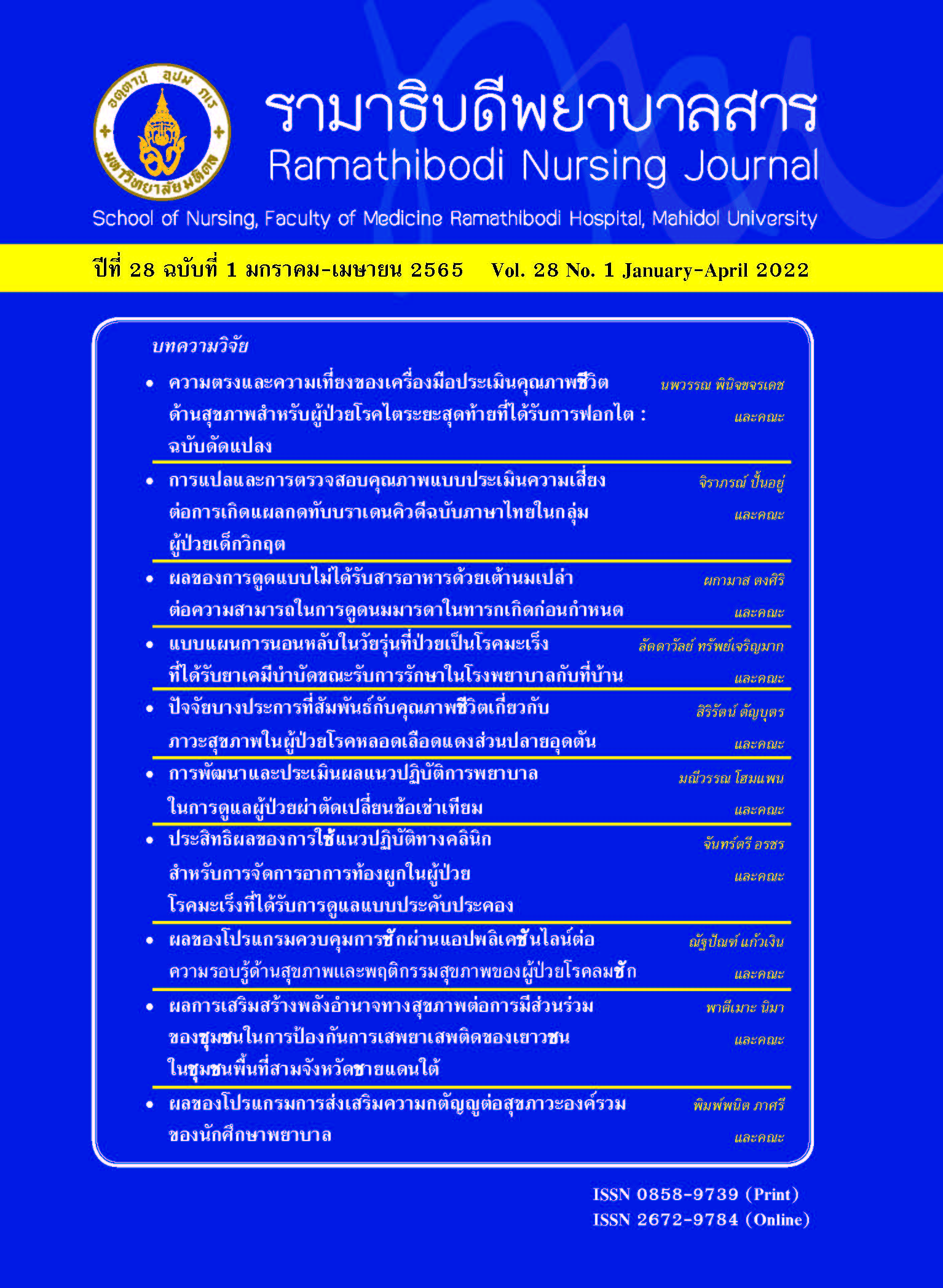Sleep Patterns in Adolescents with Cancer Receiving Chemotherapy between in Hospital and at Home
Main Article Content
Abstract
This descriptive study aimed to compare sleep patterns between hospitalization and at home in adolescents with cancer receiving chemotherapy. The purposive sample consisted of 30 adolescents aged 10-18 years old, diagnosed with all types of cancer,and hospitalized for chemotherapy in two tertiary hospitals. Data were obtained using demographic and clinical characteristics questionnaires and a sleep diary. Descriptive statistics, dependent t-test, and Wilcoxon-signed rank test were used to analyze the
data. The results revealed that most adolescents with cancer got into bed between 8:00-8:59 PM, which was similar between hospitalization and at home. Most of them woke up early between 5:00-6:59 AM, which was earlier than those at home between 7:00-
7:59 AM. The most-reported time of getting out of bed was between 7:00-7:59 AM for both in hospital and at home. When comparing sleep patterns during hospitalization with those at home, the results showed that sleep patterns were significantly different.
The hospitalized adolescents reported longer sleep latency, more night awakenings,longer total wake time after sleep onset, more daytime naps, longer total naptime, shorter total sleep time, poorer sleep quality, and less feeling refreshed after waking up. There
were no significant differences in time in bed trying to sleep after the final awakening,wake up time earlier than planned, and caffeinated drinks. These results demonstrate that it is imperative that healthcare professionals should be aware of the sleeping problems,assess sleep patterns, and plan interventions for promoting sleep quality among hospitalized adolescents receiving chemotherapy and while at home.
Keywords : Adolescent, Cancer, Sleep pattern, Chemotherapy
Article Details

This work is licensed under a Creative Commons Attribution-NonCommercial-NoDerivatives 4.0 International License.
บทความ ข้อมูล เนื้อหา รูปภาพ ฯลฯ ที่ได้รับการตีพิมพ์ในรามาธิบดีพยาบาลสาร ถือเป็นลิขสิทธิ์ของวารสาร หากบุคคลหรือหน่วยงานใดต้องการนำทั้งหมดหรือส่วนหนึ่งส่วนใดไปเผยแพร่หรือเพื่อกระทำการใด ใด จะต้องได้รับอนุญาตเป็นลายลักษณ์อักษรจากรามาธิบดีพยาบาลสารก่อนเท่านั้น
References
Brinkman JE, Tariq MA, Leavitt L, Sharma S. Physiology,growth hormone. [Updated 2021 May 7]. In: StatPearls [Internet]. Treasure island (FL): StatPearls Publishing;2022 [cited 2022 January 26]. Available from: https://www.ncbi.nlm.nih.gov/books/NBK482141/
Krueger JM, Majde JA, Rector DM. Cytokines in immune function and sleep regulation. Handb Clin Neurol.2011;98:229-40.
Yangan K, Ongiem A, Vichitvejpaisal P. Melatonin: Is it suitable for use in anesthesia?. Thai J Anesthesiol.2019;45(2):73-80. (in Thai)
Mindell JA, Owens JA. A clinical guide to pediatric sleep diagnosis and management of sleep problems. 3rd ed.China: Lippincott Williams & Wilkins; 2015
Sleep Foundation. Teens and sleep; 2021 [cited 2022 January 26]. Available from Sleep Foundation Web site:https://www.sleepfoundation.org/teens-and-sleep
Lewandowski AS, Ward TM, Palermo M. Sleep Problems in Children and Adolescents with Common Medical Conditions. Pediatr Clin North Am. 2011;58(3):699-713.
Walker AJ, Pongsing Y, Nail L, Pedhiwala N, Leo M,Price J, et al. Sleep-wake patterns of school-age children and adolescents before diagnosis and during induction chemotherapy for acute lymphocytic leukemia. J Pediatr Nurs. 2011;26(6):e37-44.
Nunes, MDR Jacob E, Adlard K, Secola R, NascimentoL. Fatigue and sleep experiences at home in children and adolescents with cancer. Oncol Nurs Forum.2015;42(5):498-506.
Olson K. Sleep-related disturbances among adolescents with cancer: a systematic review. Sleep Med. 2014;15(5):496-501.
Daniel L, Kazak E, Li , Hobbie W, Ginsberg J, Butler E,Schwartz L. Relationship between sleep problems and psychological outcomes in adolescent and young adult cancer survivors and controls. Support Care Cancer.2016;24(2):539-46.
Gordijn MS, van Litsenburg RR, Gemke RJ, Huisman J,Bierings MB, Hoogerbrugge PM, Kaspers GJ. Sleep,fatigue, depression, and quality of life in survivors of childhood acute lymphoblastic leukemia. Pediatr Blood Cancer. 2013;60(3):479-85.
Becker SP, Langberg JM, Byars KC. Advancing a biopsychosocial and contextual model of sleep in adolescence: a review and introduction to the special issue.J Youth Adolescence. 2015;44:239–70.
Rosen G, Harris AK, Liu M, Dreyfus J, Krueger J,Messinger YH. The effects of dexamethasone on sleep in young children with acute lymphoblastic leukemia. Sleep Med. 2015;16(4):503-9.
Meltzer LJ, Davis KF, Mindell JA. Patient and parent sleep in a children’s hospital. Pediatr Nurs. 2012;38(2):64-71.
Linder LA, Christian BJ. Nighttime sleep disruptions, the hospital care environment, and symptoms in elementary
school-age children with cancer. Oncol Nurs Forum.2012;39(6):553-61.
Cain N, Gradisar M. Electronic media use and sleep in school-aged children and adolescents: A review. Sleep Med. 2010;11(8):735-42.
Zupanec S, Jones H, Stremler R. Sleep habits and fatigue of children receiving maintenance chemotherapy for ALL and their parents. J Pediatr Oncol Nurs. 2010;27(4):217-28.
Garcia AN, Salloum IM. Polysomnographic sleep disturbances in nicotine, caffeine, alcohol, cocaine, opioid,and cannabis use: A focused review. Am J Addict.2015;24(7):590-8.
Borbély AA, Daan S, Wirz-Justice A, Deboer T. The two-process model of sleep regulation: a reappraisal. J Sleep Res. 2016;25(2):131-43.
Sanitlou N, Sartphet W,Naphaarrak Y. Sample size calculation using G*power program. J of Suvarnabhumi Tech. 2019;5(1):496-507.
Kaewkungwal J. Sample size calculations in clinical research. In Pitisuttithum P, Picheansoonthon C, editors.Textbook of clinical research. 4thed. Bangkok: Amarin Printing and Publishing Public Company Limited; 2018.p.185-228.
Carney CE, Buysse DJ, Ancoli-Israel S, Edinger JD,Krystal AD, Lichstein KL, Morin CM. The consensus sleep diary: standardizing prospective sleep selfmonitoring.Sleep. 2012;35(2):287-302.
Chookanhom P. Fatigue and sleep disturbance in hospitallized adolescents with cancer receiving chemotherapy [thesis]. Nakhon Pathom: Mahidol University; 2019. (in Thai).
Linder LA, Christian BJ. Nighttime sleep characteristics of hospitalized school-age children with cancer. J Spec Pediatr Nurs. 2013;18(1):13-24.
Leone RD, Emens LA. Targeting adenosine for cancer immunotherapy. J Immunotherapy Cancer. 2018;6(57):1-9.
Benzer F, Kandemir FM, Kucukler S, Comaklı S, Caglayan C. Chemoprotective effects of curcumin on doxorubicininduced
nephrotoxicity in wistar rats: by modulating inflammatory cytokines, apoptosis, oxidative stress and oxidative DNA damage. Arch Physiol Biochem.2018;124(5):448-57.


